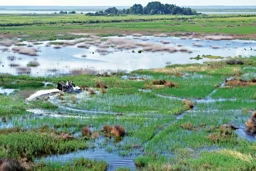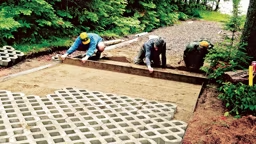We love summer days at the lake. Even the occasional rainy day is welcome, as social circles tuck into the kitchen table to finish a puzzle, play solitaire or build a house of cards. When that gentle summer shower crescendos into a full-blown thunderstorm, however, our attention is diverted to the clamor of raindrops pummeling the roof and the drama of a mini flood pouring over the slope and down the hill and filling our fishing boat that bumps our shoreline.
Thunderstorms can be violent events that stress our homes and landscapes because of the amount and speed of the rainwater.
Your life as a raindrop
Under natural circumstances, this stress is fairly minimal. For example, picture an intact woodland, maybe your wooded lot prior to the construction of your cabin. Now pretend that you’re a raindrop careening out of a cumulonimbus cloud. If you’re falling onto a relatively intact woodland, you’re going to hit the leaves of a big maple first, then drip down to a serviceberry tree that’s about half the size of the maple, then to a witch hazel shrub that’s again half the size of the serviceberry, then to a sweet fern that blankets the ground. The ground is a sponge, a pervious surface, and your final destination. By the time you’ve reached this ground, your previous plant interceptors have slowed you down from cheetah to glacier. This slow speed facilitates infiltration, which means that you’re absorbed into the soil, and any impurities that you may have picked up during your travels are then filtered and broken down by bacteria that live in the soil.
Under developed circumstances, the raindrop scenario is much simpler but more problematic. You fall from the same cumulonimbus cloud at cheetah speed and SMACK! You hit the asphalt driveway or concrete patio – impervious surfaces – and quickly run off into a nearby storm sewer or down a slope, with little chance of absorption at the source.
The consequences
This isn’t a problem until there’s a whole lot of raindrops. Their volume, combined with high speeds, will take topsoil off of your hillside and carry fertilizers and broad-leaf weed killers with them into your lake.
So, once the storm has passed, you’ll need to fix the erosion damage caused by so much water dumped in so little time and with little chance of interception. There’s also the much bigger problem of cleaning up the lake! Fertilizers especially, when carried with storm water running over the surface of treated lawns into adjacent bodies of water, add unnecessary nutrients to our lakes and streams. Increased nutrients (labeled as “nutrient loading”) promote algal blooms, which cause reduced water clarity, decreased oxygen levels and ultimately decreased native fish numbers and diversity. For those of us who trek to the cabin to fish, this is not an issue we want to ignore.
7 things you can do
“Impervious and pervious” – we’re seeing these buzzwords a lot lately. To be clear, there are varying degrees of both. To simplify, a pervious surface, like moss, allows fluids, like storm water, to pass through. An impervious surface, like concrete, deflects or allows fluids to pool instead of absorb.
So, if you’re concerned about minimizing the effects of storm-water runoff at the cabin, what can you do? How do you implement the concept of pervious? The photo gallery below details seven options that will facilitate the absorption of storm water into your landscape.
Thunderstorms can be violent events that stress our homes and landscapes because of the amount and speed of the rainwater.
Your life as a raindrop
Under natural circumstances, this stress is fairly minimal. For example, picture an intact woodland, maybe your wooded lot prior to the construction of your cabin. Now pretend that you’re a raindrop careening out of a cumulonimbus cloud. If you’re falling onto a relatively intact woodland, you’re going to hit the leaves of a big maple first, then drip down to a serviceberry tree that’s about half the size of the maple, then to a witch hazel shrub that’s again half the size of the serviceberry, then to a sweet fern that blankets the ground. The ground is a sponge, a pervious surface, and your final destination. By the time you’ve reached this ground, your previous plant interceptors have slowed you down from cheetah to glacier. This slow speed facilitates infiltration, which means that you’re absorbed into the soil, and any impurities that you may have picked up during your travels are then filtered and broken down by bacteria that live in the soil.
Under developed circumstances, the raindrop scenario is much simpler but more problematic. You fall from the same cumulonimbus cloud at cheetah speed and SMACK! You hit the asphalt driveway or concrete patio – impervious surfaces – and quickly run off into a nearby storm sewer or down a slope, with little chance of absorption at the source.
The consequences
This isn’t a problem until there’s a whole lot of raindrops. Their volume, combined with high speeds, will take topsoil off of your hillside and carry fertilizers and broad-leaf weed killers with them into your lake.
So, once the storm has passed, you’ll need to fix the erosion damage caused by so much water dumped in so little time and with little chance of interception. There’s also the much bigger problem of cleaning up the lake! Fertilizers especially, when carried with storm water running over the surface of treated lawns into adjacent bodies of water, add unnecessary nutrients to our lakes and streams. Increased nutrients (labeled as “nutrient loading”) promote algal blooms, which cause reduced water clarity, decreased oxygen levels and ultimately decreased native fish numbers and diversity. For those of us who trek to the cabin to fish, this is not an issue we want to ignore.
7 things you can do
“Impervious and pervious” – we’re seeing these buzzwords a lot lately. To be clear, there are varying degrees of both. To simplify, a pervious surface, like moss, allows fluids, like storm water, to pass through. An impervious surface, like concrete, deflects or allows fluids to pool instead of absorb.
So, if you’re concerned about minimizing the effects of storm-water runoff at the cabin, what can you do? How do you implement the concept of pervious? The photo gallery below details seven options that will facilitate the absorption of storm water into your landscape.
To be fair, the problem of storm-water runoff at a remote cabin on a lake certainly pales in comparison to the big city, where impervious surfaces such as roads, sidewalks, buildings, cars and houses prevail; deflecting storm water and compromising sometimes-relic storm-sewer infrastructures. But, as our precious lakes become more and more developed, incorporating pervious surfaces within our homes and landscapes should be part of the planning process so we’re intercepting the problem before it starts.
Jennifer Baker is a professional landscape problem-solver who focuses on natural solutions like permeable landscapes, and she has a passion for all things cabin. See more of her work at www.sparrowlandplanning.com.
Jennifer Baker is a professional landscape problem-solver who focuses on natural solutions like permeable landscapes, and she has a passion for all things cabin. See more of her work at www.sparrowlandplanning.com.










